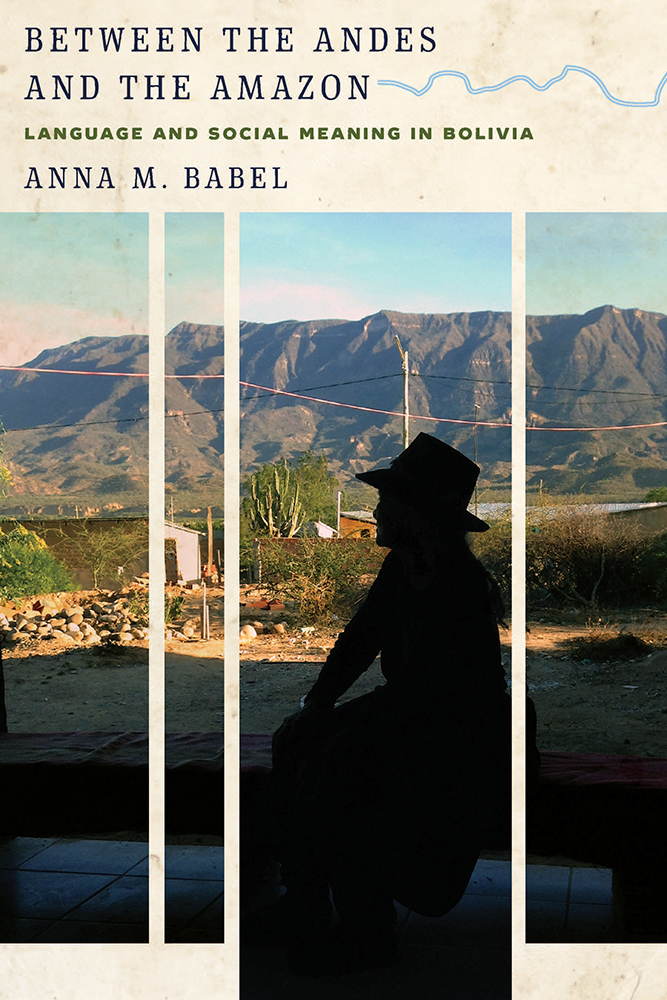Between the Andes and the Amazon
Language and Social Meaning in Bolivia
Paperback ($35.00), Ebook ($35.00)
Buy
Why can’t a Quechua speaker wear pants? Anna M. Babel uses this question to open an analysis of language and social structure at the border of eastern and western, highland and lowland Bolivia. Through an exploration of categories such as political affiliation, ethnic identity, style of dress, and history of migration, she describes the ways that people understand themselves and others as Quechua speakers, Spanish speakers, or something in between.
Between the Andes and the Amazon is ethnography in storytelling form, a rigorous yet sensitive exploration of how people understand themselves and others as members of social groups through the words and languages they use.
Drawing on fifteen years of ethnographic research, Babel offers a close examination of how people produce oppositions, even as they might position themselves “in between” those categories. These oppositions form the raw material of the social system that people accept as “normal” or “the way things are.” Meaning-making happens through language use and language play, Babel explains, and the practice of using Spanish versus Quechua is a claim to an identity or a social position. Babel gives personal perspectives on what it is like to live in this community, focusing on her own experiences and those of her key consultants. Between the Andes and the Amazon opens new ways of thinking about what it means to be a speaker of an indigenous or colonial language—or a mix of both.
Between the Andes and the Amazon is ethnography in storytelling form, a rigorous yet sensitive exploration of how people understand themselves and others as members of social groups through the words and languages they use.
Drawing on fifteen years of ethnographic research, Babel offers a close examination of how people produce oppositions, even as they might position themselves “in between” those categories. These oppositions form the raw material of the social system that people accept as “normal” or “the way things are.” Meaning-making happens through language use and language play, Babel explains, and the practice of using Spanish versus Quechua is a claim to an identity or a social position. Babel gives personal perspectives on what it is like to live in this community, focusing on her own experiences and those of her key consultants. Between the Andes and the Amazon opens new ways of thinking about what it means to be a speaker of an indigenous or colonial language—or a mix of both.
“This superb study reveals the linguistic, sociopolitical, and cultural complexity confronted by Quechua and Spanish speakers and by Quechua-Spanish bilinguals in central Bolivia.”—Choice
“This book is a model of both rigorous interdisciplinary research, and compassionate, engaged ethnography.”—Anthropological Linguistics
"(This book) is a lovely portrait of a community and how language is part of its social fabric, demonstrating not only that language and the social are inseparable, but also how they interact."—Scott Kiesling, Language in Society
“Babel’s engaging and insightful analysis highlights the complexity inherent in linguistic and cultural contact. This beautifully written ethnography will be a crucial resource for linguistic anthropologists and scholars of Latin America.”—Rusty Barrett, author of From Drag Queens to Leathermen: Language, Gender, and Gay Male Subcultures
“An innovative book, grounded in ethnography, while never losing sight of the linguistic details that pervade and inform our social world. One hopes that more books will be written in this spirit.”—Anthony K. Webster, author of Intimate Grammars: An Ethnography of Navajo Poetry
“(This) book constitutes a valuable example of how linguistic anthropology can enrich Andean sociolinguistics in Latin America by moving away from the positivist, modernist linguistics that still haunts the field (Lewis 2018) and by providing an interdisciplinary account that should interest sociolinguists, linguistic anthropologists and scholars of Latin American Studies from both the global north and the global south.”—Virginia Zavala, Wiley
“… the author skilfully reveals the social structural nuances underpinning Quechua–Spanish bilingual language habits in a part of the Andes that is neither quite Andes nor quite Amazonia. From the perspective of Andeanist ethnography and linguistic anthropology alike, the book provides a refreshingly new perspective.”—Rosaleen Howard, Journal of Latin American Studies
“This book is a model of both rigorous interdisciplinary research, and compassionate, engaged ethnography.”—Anthropological Linguistics
"(This book) is a lovely portrait of a community and how language is part of its social fabric, demonstrating not only that language and the social are inseparable, but also how they interact."—Scott Kiesling, Language in Society
“Babel’s engaging and insightful analysis highlights the complexity inherent in linguistic and cultural contact. This beautifully written ethnography will be a crucial resource for linguistic anthropologists and scholars of Latin America.”—Rusty Barrett, author of From Drag Queens to Leathermen: Language, Gender, and Gay Male Subcultures
“An innovative book, grounded in ethnography, while never losing sight of the linguistic details that pervade and inform our social world. One hopes that more books will be written in this spirit.”—Anthony K. Webster, author of Intimate Grammars: An Ethnography of Navajo Poetry
“(This) book constitutes a valuable example of how linguistic anthropology can enrich Andean sociolinguistics in Latin America by moving away from the positivist, modernist linguistics that still haunts the field (Lewis 2018) and by providing an interdisciplinary account that should interest sociolinguists, linguistic anthropologists and scholars of Latin American Studies from both the global north and the global south.”—Virginia Zavala, Wiley
“… the author skilfully reveals the social structural nuances underpinning Quechua–Spanish bilingual language habits in a part of the Andes that is neither quite Andes nor quite Amazonia. From the perspective of Andeanist ethnography and linguistic anthropology alike, the book provides a refreshingly new perspective.”—Rosaleen Howard, Journal of Latin American Studies
 The University of Arizona Press
The University of Arizona Press

